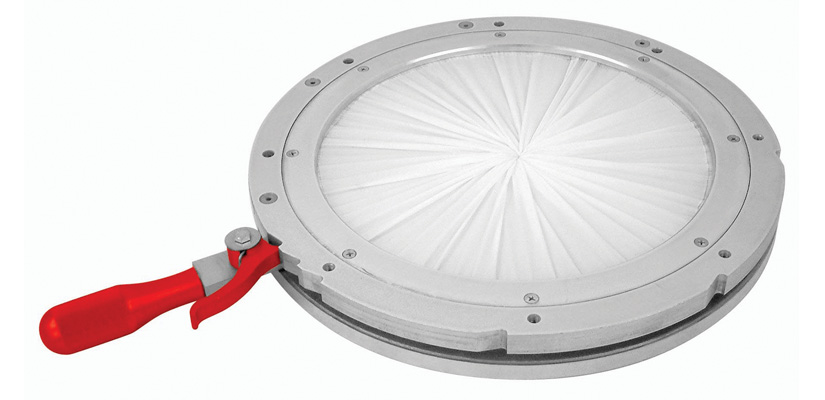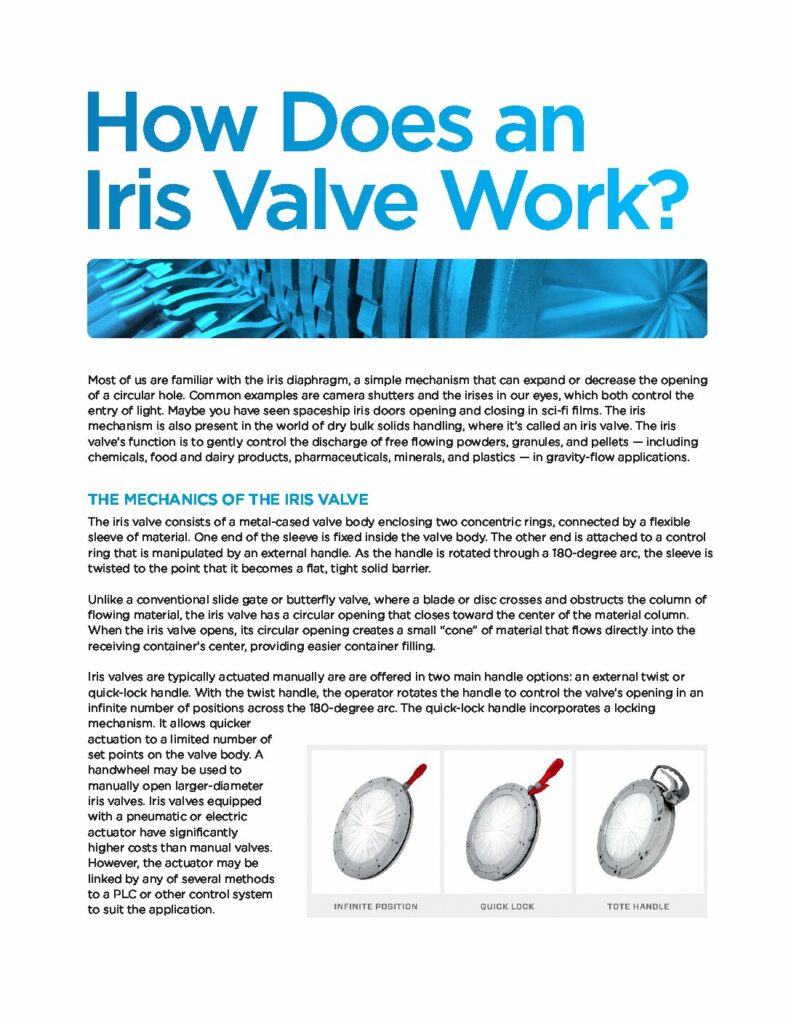
Most of us are familiar with the iris diaphragm, a simple mechanism that can expand or decrease the opening of a circular hole. Common examples are camera shutters and the irises in our eyes, which both control the entry of light. Maybe you have seen spaceship iris doors opening and closing in sci-fi films. The iris mechanism is also present in the world of dry bulk solids handling, where it’s called an iris valve. The iris valve’s function is to gently control the discharge of free flowing powders, granules, and pellets — including chemicals, food and dairy products, pharmaceuticals, minerals, and plastics — in gravity-flow applications.
Courtesy of Vortex Valves.
THE MECHANICS OF THE IRIS VALVE
The iris valve consists of a metal-cased valve body enclosing two concentric rings, connected by a flexible sleeve of material. One end of the sleeve is fixed inside the valve body. The other end is attached to a control ring that is manipulated by an external handle. As the handle is rotated through a 180-degree arc, the sleeve is twisted to the point that it becomes a flat, tight solid barrier.
Unlike a conventional slide gate or butterfly valve, where a blade or disc crosses and obstructs the column of flowing material, the iris valve has a circular opening that closes toward the center of the material column. When the iris valve opens, its circular opening creates a small “cone” of material that flows directly into the receiving container’s center, providing easier container filling.
 COMPONENT CONSTRUCTION MATERIALS
COMPONENT CONSTRUCTION MATERIALS
The valve components can be made of various materials to suit your application.
Valve body. The iris valve body is commonly constructed of aluminum. The aluminum may be anodized or Teflon™ coated to suit a direct-contact application with a caustic environment. Type 304 and 316L stainless steels are also available for sanitary applications but have a significantly higher cost than aluminum. Some iris valve suppliers offer aluminum valve bodies in which only the material-contact areas are lined with stainless steel, which reduces the valve’s cost.
Control ring and handle materials. The iris valve control ring can be made of polycarbonate, bronze, or stainless steel, depending on the supplier. The ring’s external twist or quick-lock handle, as well as the locking mechanism on a quick-lock handle, can also be made of polycarbonate, bronze, or stainless steel. Carefully selecting construction materials for these components will prevent operating problems.
Sleeve materials. The sleeves for iris valves are available in a variety of materials to accommodate a range of bulk handling requirements. A sleeve made of two layers of fabric is often used to handle a fine powder that generates dust. Iris valves are typically available in, but are not limited to, the following types of sleeve materials:

- Nylon
- Terylene
- Teflon
- Urethane
- Buna-N (Nitrile) Rubber
- Natural Rubber
It is important to consult your supplier on which sleeve material is best for handling specific applications, as some of the least assuming materials can be caustic or abrasive.
COMPONENT CONSTRUCTION MATERIALS
While the iris valve can be an efficient and cost-effective means of controlling the discharge of dry bulk solids in many applications, it does have limitations. Before selecting an iris valve, consider these pros and cons.
PROS:
- Inexpensive when manually actuated.
- Light-weight and disassembles easily, making it easy to install, clean, and maintain, especially in confined areas.
- Ideal for use with friable and explosive materials. (In applications handling explosive materials, the valve and surrounding equipment must be properly grounded to avoid electrostatic discharges, and when the valve is equipped with an electric actuator or controls, these must meet applicable NEMA standards in the US or ATEX standards in European Union countries.)
- Unobstructed opening that opens and closes toward the valve’s center, allowing the discharged material to evenly fill containers.
CONS:
- Cannot handle high-volume, continuous material flow.
- Cannot handle heavy, abrasive material.
- Cannot close through a standing column of material.
- Cannot handle frequent open-close cycles in direct contact applications.
- Cannot support heavy equipment suspended from it.
- Has a bolt-hole mounting pattern that usually differs from supplier.
OTHER CONSIDERATIONS
Torque. Iris valves are subject to torsional stress, especially as they are being closed. Handles and locking mechanisms made of polycarbonate are subject to distortion and breakage. Polycarbonate control rings are subject to the same problems. For applications that require a lot of torque pressure, a stainless steel handle and mechanism is best.
Construction material. Iris valves containing bronze control rings are subject to metal flaking inside the valve due to the metal-on-metal contact between the bronze control ring and the metal valve body. This can lead to damaged sleeves, introduction of foreign material and erratic actuation of the valve. A stainless steel control ring will provide longer service life, and a Type 316L stainless steel control ring is best for handling corrosive materials.
Mounting to existing equipment. Most iris valves have standard bolt hole-mounting patterns offered as a standard, however, this pattern may differ from manufacturer to manufacturer. Mating spool pieces and ferrule type connections can also be applied to the valve to match mounting requirements.
IS AN IRIS VALVE RIGHT FOR YOU?
For help determining whether the iris valve is right for any dry bulk material application, consult an iris valve supplier. Based on the details provided, the supplier can determine if the iris valve is the correct valve choice. If it is, work closely with the supplier to select the right valve components, construction materials, and actuation method to keep the iris valve operating smoothly and efficiently in your handling operation.
